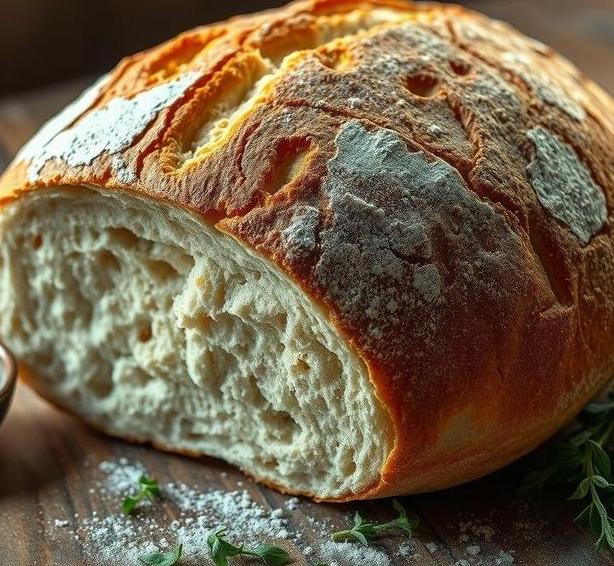Italian bread – it’s warm, crusty, and brings a touch of rustic charm to any meal. Whether it’s the classic Ciabatta, a loaf of Focaccia, or the hearty Pane di Altamura, Italian bread is often the star of the table. But as with all fresh-baked goods, you may wonder: How long does this delicious loaf really last? More importantly, How can I make sure it stays fresh for as long as possible?
In this guide, we’re diving deep into the life cycle of Italian bread, from when you first bring it home to when it’s no longer a delightful treat. We’ll explore how to properly store it, recognize when it’s past its prime, and make sure you get the most out of each loaf. By the end, you’ll have all the knowledge to keep your Italian bread as fresh as possible, for as long as possible.
Can Italian Bread Go Bad?
Absolutely, yes – but it doesn’t happen overnight! Just like any other bread, Italian bread has a shelf life and can deteriorate over time due to exposure to air, moisture, and heat. The natural yeast and bacteria that give it that authentic flavor can also contribute to spoilage if not properly cared for.
- Moisture Loss: The dry environment around the bread can cause the loaf to lose moisture, turning it hard and stale.
- Mold Growth: If the bread isn’t stored properly, mold can start to grow, especially in humid environments.
- Bacterial Growth: Spoilage bacteria can develop if the bread is exposed to warmth and moisture for prolonged periods.
But here’s the good news: properly storing Italian bread can extend its lifespan considerably, and there are tricks to salvage a loaf that’s on the brink of staleness. Let’s break it down more in-depth.
Shelf Life For Italian Bread

When it comes to the shelf life of Italian bread, freshness is key. But depending on factors like type, ingredients, and storage conditions, the bread’s longevity can vary. Here’s a more detailed breakdown:
Unopened, Store-Bought Italian Bread
- At room temperature: Typically lasts 3 to 4 days. The crust may become less crisp, and the bread inside may lose its soft texture as time goes on.
- In the fridge: It can last up to a week, but refrigeration tends to dry out bread faster, affecting both the flavor and texture.
- Frozen: If you plan on not using it right away, freezing it will give you up to 3 months. Freezing is by far the best option to preserve it for longer without compromising too much on taste.
Homemade Italian Bread
- At room temperature: Homemade bread, especially if it contains less preservatives, may only last 2 to 3 days. The fresher it is, the faster it’ll spoil, so it’s best to consume it soon after baking.
- In the fridge: If you decide to refrigerate it, it can stay fresh for about 5 to 7 days, but be prepared for a loss of that perfect soft crumb.
- Frozen: Freezing homemade Italian bread is also a great option, extending its life to about 3 months.
Common Signs Of Spoilage
If you notice any of the following signs, your Italian bread is likely past its prime. But fear not, some of these may be reversible with the right techniques:
- Hard, Dry Texture: If the bread feels like a brick or has turned completely dry inside, it’s lost its fresh, fluffy texture. You can revive it by sprinkling a bit of water on it and warming it in the oven to restore some moisture.
- Mold: The most obvious sign of spoilage. Mold typically appears as fuzzy, colorful spots (green, blue, or white), often on the cut edges. If you spot mold, it’s best to discard the entire loaf, as the spores can spread throughout.
- Sour or Off Odor: If the bread smells unusually sour or musty, it’s a clear sign it has gone bad. A slight tanginess is normal with sourdough, but anything that smells rotten or off should be tossed.
- Discoloration: Faded color or an unusual change in the bread’s appearance might indicate bacterial or mold growth.
- Wet, Damp Feel: Bread that feels moist or soggy could be a sign that it’s been improperly stored, and that mold is likely forming beneath the surface.
How To Store Italian Bread?

Proper storage is the key to making sure your Italian bread stays fresh as long as possible. Here’s a deep dive into your best options:
At Room Temperature
- Paper Bag or Bread Box: Italian bread loves to breathe. The best way to store it at room temperature is in a paper bag or a breathable bread box. This helps prevent moisture buildup, which can lead to mold. The paper allows air circulation, helping the crust stay crispy.
- Avoid Plastic Bags: While convenient, plastic bags trap moisture and lead to soft, soggy bread. If you have to use one, make sure it’s loosely sealed to allow some airflow.
In The Freezer
Freezing is the best option for long-term storage. If you’re freezing your Italian bread:
- Wrap in Plastic or Aluminum Foil: Before placing the bread in a freezer bag, wrap it tightly in plastic wrap or foil. This prevents freezer burn and protects the texture.
- Slice First: It’s always a good idea to slice the loaf before freezing so you can thaw individual slices as needed. This way, you won’t need to defrost the entire loaf at once.
- Reheat Correctly: When ready to eat, remove the bread from the freezer and let it thaw at room temperature. For the best results, place it in the oven for a few minutes to crisp up the crust.
In The Fridge
While refrigeration is a last resort, it can help preserve bread in hot, humid climates. Just be mindful that it will dry out more quickly. If you’re refrigerating it:
- Wrap it Well: Use plastic wrap or store it in an airtight container to minimize exposure to air and prevent it from becoming too dry.
Expert Tips For Keeping Italian Bread Fresh
- Slice Only What You Need: Instead of slicing the whole loaf at once, slice only the portion you plan to eat immediately. This prevents air from drying out the rest of the loaf.
- Revive Stale Bread: If your bread is getting a bit stale, try wrapping it in a damp towel and placing it in a 350°F (175°C) oven for about 10 minutes. This will help soften it and bring back some of that fresh, just-baked quality.
- Use a Bread Box: While not essential, a bread box creates the ideal environment for bread storage – cool, dry, and out of direct sunlight. It can help maintain the texture and flavor for a longer period.
- Avoid Refrigerating in Hot Weather: The fridge is a quick fix, but if you’re in a hot climate, freeze the bread instead. The cold, dry air of the fridge will make the bread stale faster than freezing it.
FAQs
Can Italian Bread Go Bad If Left Out?
Yes, Italian bread can go bad if left out for too long. Bread should be stored in a cool, dry place and eaten within a few days to maintain its freshness. If left exposed to air, it can dry out or develop mold quickly.
How Long Does Italian Bread Last At Room Temperature?
Italian bread typically lasts about 2 to 3 days at room temperature when stored in a breadbox or paper bag. After this, it may start to dry out or spoil. For longer freshness, it should be refrigerated or frozen.
Can Italian Bread Go Bad In The Refrigerator?
Refrigerating Italian bread can cause it to become stale more quickly due to the colder temperatures causing the starches in the bread to crystallize. However, it can still last up to a week when stored in an airtight bag.
How Do I Know If Italian Bread Has Gone Bad?
Signs that Italian bread has gone bad include visible mold, an off smell, or an excessively dry or hard texture. If the bread feels slimy or has developed any unusual discoloration, it should be discarded.
Can I Freeze Italian Bread To Make It Last Longer?
Yes, freezing Italian bread is an effective way to preserve its freshness. When frozen, it can last for 3 to 6 months. To prevent freezer burn, wrap the bread tightly in plastic wrap or aluminum foil before freezing.
What Is The Best Way To Store Italian Bread?
The best way to store Italian bread is in a cool, dry place, ideally in a breadbox or a paper bag. If you plan to consume it within a few days, room temperature storage is fine. For longer preservation, freezing is recommended.
Can Italian Bread Mold Even If Stored Properly?
Yes, Italian bread can still mold if it’s exposed to moisture or if it is stored improperly for a prolonged period. Mold growth is typically faster in humid environments or if the bread is stored in plastic without proper ventilation.
How Long Does Frozen Italian Bread Last?
Frozen Italian bread can last for 3 to 6 months. To ensure the best quality, it should be wrapped tightly to prevent moisture loss and freezer burn.
Can Italian Bread Be Safely Eaten After The Expiration Date?
Eating Italian bread after its expiration date is generally not recommended, as it may have dried out or developed mold. If the bread appears and smells normal, it might be okay to consume, but always check for signs of spoilage.
How Can I Revive Stale Italian Bread?
To revive stale Italian bread, you can sprinkle it with water and warm it in the oven at a low temperature (around 300°F) for 5 to 10 minutes. This helps restore moisture and improves the texture.